Scotch Macaskill's Wildlife Blog
IMPORTANT: Please note that from April 2009 this Blog's Web address changed as a result of a switch in the blogging platform we use. It's still an integral part of the Wildlife Pictures Online website and, we hope, will continue providing entertaining and enjoyable content in the form of wildlife images, news, views and information.
For the most recent posts, links, and other resources, please visit the new Wldlife Photography Blog.
|
New Photography Articles
December 5, 2005
|
Three photography articles have been added to the main site. You can view these and other photography articles from the Photo Info category.
Two of the new articles hinge around digital photography while the third offers some basic tips that apply to all forms of photography.
If you're considering buying a digital camera, you've probably come across the term "megapixels". To help you understand this better - and avoid being duped by slick salespeople - you should read
"How Many Megapixels Do
You Need?"
A question that often bothers those new to digital photography is what to do with all their digital images.
"Make the
Most of Your Digital Images" offers advice and tips on producing prints and slideshows from digital photos.
If you're wanting to improve your photography,
"4 Simple Tips for Taking Better Photos" provides easy-to-follow tips that will help you turn more of your photos into "keepers" that you'll be happy to put in an album and proud to show off to others.
|
Today's Picture: African Python and Prey
December 5, 2005
|
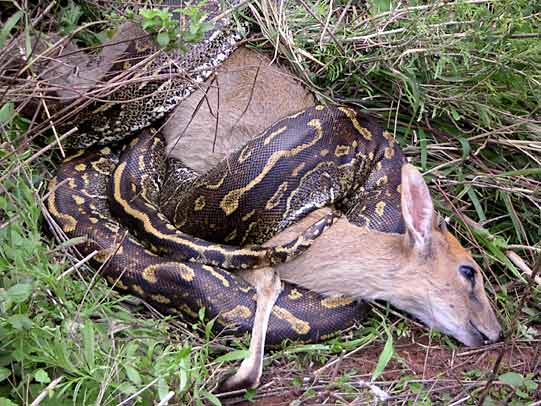
Photo Details: African Rock Python (Python sebae) with its victim, a sub-adult grey male duiker, Nagle Dam and Game Reserve, KwaZulu-Natal, South Africa. Photograph by Rob Markham.
Camera: Minolta DiMAGE X20;
Shutter Speed: 1/60;
Aperture: f3.7;
ISO: 100
Additional Info:
Rob Markham, a former game ranger and experienced conservationist who took the photograph, says the python was around 4m (12 ft) long. It was first spotted mid-afternoon and by about 8pm that night had swallowed the duiker.
The python is Africa's largest snake and can grow to a length of 5m (15-16ft) or more. Pythons eat a wide variety of warm-blooded animals, ranging from game birds and domestic fowls to small antelope and monkeys. Because of its jaw structure, a python can swallow prey substantially larger than its head.
|
Today's Picture: Elephant Cows, Close-up
December 7, 2005
|
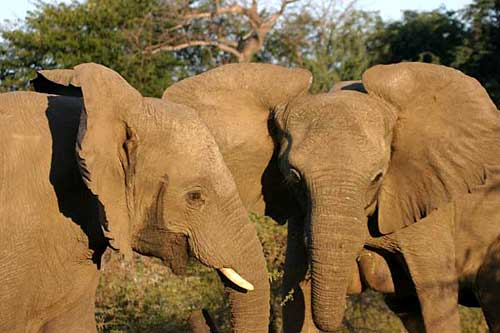
Photo Details: Elephant cows (Loxodonta africana) with their ears spread, Lower Zambezi National Park, Zambia.
Camera: Canon EOS Digital Rebel;
Lens: Canon 100-400 IS zoom;
Focal Length: 100mm;
Shutter Speed: 1/800;
Aperture: f5.6;
ISO: 400
|
Today's Picture: Zebra Foal
December 10, 2005
|
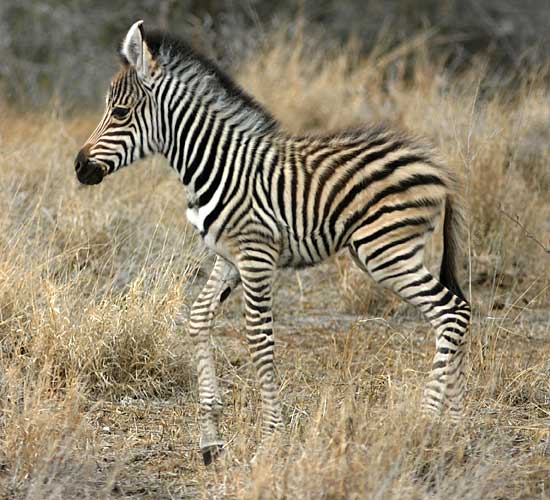
Photo Details: Young zebra foal (Equus burchelli), Kruger National Park, South Africa.
Camera: Canon EOS Digital Rebel;
Lens: Canon 300mm F4;
Focal Length: 300mm;
Shutter Speed: 1/800;
Aperture: f4;
ISO: 200
|
Today's Picture: African Sunrise
December 12, 2005
|
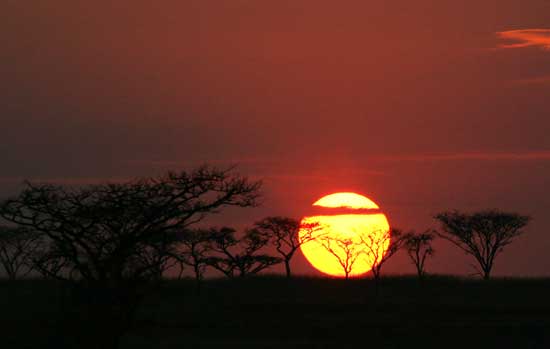
Photo Details: As it's summer in South Africa and we're fast approaching our longest day (summer solstice in the southern hemisphere), it seems appropriate to feature a typical African sunrise, taken in the acacia thornveld of Weenen Nature Reserve, KwaZulu-Natal.
On December 21, the sun's rays will be directly overhead along the Tropic of Capricorn (the latitude line at 23.5° south, passing through Brazil, South Africa, and Australia).
Camera: Canon EOS Digital Rebel;
Lens: Canon 100-400 IS Zoom;
Focal Length: 340mm;
Shutter Speed: 1/800;
Aperture: f10;
ISO: 400
|
Today's Picture: Comb Duck (Knob-billed duck)
December 21, 2005
|
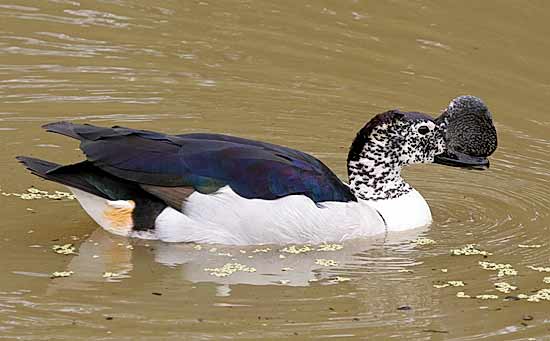
Photo Details: Comb duck (Sarkidiornis melanotos), also known as Knob-billed duck, Mkhuze Game Reserve, KwaZulu-Natal, South Africa.
The comb or knob on the bill of male ducks varies in size, being largest in breeding season. Strange what attracts the opposite sex!
Comb duck are widely distributed across Africa, Madagascar and southern Asia. They are normally seen in small groups, often on the banks of rivers and pans or near marshes.
The males (drakes) are twice the size of females, and their dark dorsal surfaces are glossed with metallic-violet, purple, bronze and green.
Camera: Canon EOS 350D;
Lens: Canon 100-400 IS Zoom;
Focal Length: 260mm;
Shutter Speed: 1/200;
Aperture: f9;
ISO: 400
|
| |
| Back to top of page
|
|
Previous Entries
By Month
By Category
My Original Blog
2005 Entries
2004 Entries
2003 Entries
Who Am I?
Brief Bio
|

Home /
Blog /
About /
Contact
Contact Details: Scotch Macaskill, Dirt Road Traders, Currys Post Road, Howick, KwaZulu-Natal,
South Africa. Tel: +27 (0)82 578 2329. Privacy: Your privacy is guaranteed.
See our Privacy Policy for more. This site accepts advertising and other forms of compensation - see
Disclosure and Advertising for details.
Site updated: 2019. Copyright © 2002 - 2019 Scotch Macaskill
|





